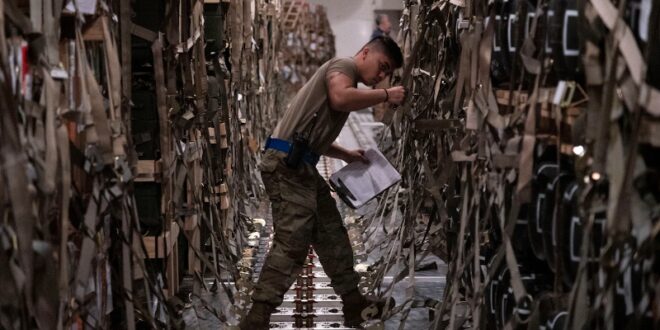After months of delays in the US Congress, an overwhelming bipartisan majority approved a new $61 billion aid package for Ukraine. Last week’s vote was a long time coming: the last time Congress authorized funding for Ukraine was December 2022.
Before that, the US had allocated a total of $116 billion in aid for Ukraine. While this might seem like a lot of money, it is less than 0.02 percent of America’s gross domestic product over the same period. Additionally, most of the money allocated to support Ukraine never actually leaves the US: it remains in America supporting US defense industry production.
Even so, the issue of supporting Ukraine became a hotly contested topic of political debate inside the Republican Party, which holds a wafer thin majority in the House of Representatives. One small but vocal faction of isolationists had called for the end of US aid to Ukraine (and Israel and Taiwan, too). Meanwhile, the more traditional “Reaganesque” wing of the party wants more aid to be provided.
It all came down to House Speaker Mike Johnson to manage the divisions inside his own party. Soon after Russia’s invasion in 2022, he was supportive of Ukraine. As the months went by, he changed his views and voted against additional US aid. Since becoming speaker he has kept his cards close to his chest and would not commit to a timetable for a vote. Finally, after months of delay, Johnson decided to bring a vote forward on Ukraine aid in the House. This paved the way for Senate approval and President Joe Biden signing it off.
There are three reasons why Johnson changed his mind. The first was that Donald Trump did too. The week before the vote, Johnson visited the former president at his residence in Florida. Nobody knows for sure what they discussed, but Ukraine seems likely. That Trump did not directly criticize the aid package for Ukraine after the meeting, following months of disapproval, was a sign of his indirect support. Johnson thus felt politically reassured to push for more Ukraine aid despite pressure from the isolationists in his own party.
Secondly, intelligence briefings would have played a role. The House speaker is second in the presidential line of succession, so Johnson is privy to high-level and sensitive intelligence briefings that most members in Congress are not. It is likely that the briefings he received about Russia’s activities in Ukraine convinced him it was time to provide more American aid.
Finally, Iran’s large-scale missile and drone barrage against Israel probably forced Johnson to support a vote for Ukraine aid. Many in Washington’s foreign policy community recognize that military cooperation between Moscow and Tehran is a threat: what happens in Ukraine can affect other regions such as like the Middle East. For example, the technology used by the Iranian drones that flew through Iraqi and Jordanian airspace before targeting Israel was perfected in Ukraine.
And, in the same way that additional US support for Ukraine is divisive for some Republicans, additional support for Israel is also controversial for some Democrats. If Johnson wanted to get more aid for Israel passed, the easiest way was to do it alongside an aid package for Ukraine.
So what are the implications of all this for US politics and the presidential race? If recent aid packages are any gauge, $61 billion should last Ukraine a long time. This was by design, as it means no new heated political debate about Ukraine before the US elections in November.
However, the issue was never likely to feature prominently in the presidential campaign. Unless Americans are directly involved in a conflict, the average voter does not think much about foreign policy. Most go to the polls for bread and butter issues such as the economy, the cost of groceries and access to affordable healthcare. Furthermore, most Americans remain supportive of helping Ukraine. It is elements on the fringes of the political scene that remain the most critical of US support.
More American support for Ukraine could not come at a more crucial time in the war. US funding for Ukraine had run dry. Although Europe filled the gap, the lack of American assistance has been felt on the front lines. The Russian capture of Avdiivka from Ukraine in February was the most apparent example of how the lack of US aid impacted the battlefield. Shortages of artillery shells and anti-aircraft missiles have been widely reported. When I visited Ukraine last month, I was shocked to learn that Ukrainian soldiers were rationing ammunition for their rifles. With this new injection of aid, this dire situation will change.
Russia is on a war footing and has shown no desire for a negotiated settlement. Meanwhile, Ukrainians know they are fighting a war for national survival. With Congress finally acting, it is now up to the White House to use this new funding to arm Ukraine with the weapons it needs, not just to survive but to win.
 Eurasia Press & News
Eurasia Press & News



